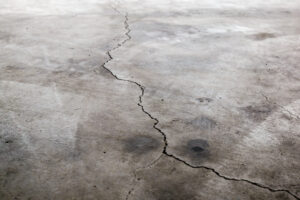Concrete Repair, Maryland
Concrete cracking is a major problem that arises when working with the material. Epoxy is the most dependable and practical solution, but there are other options. The use of epoxy to repair concrete cracks is the primary emphasis of this article; however, other methods for repairing concrete fractures are briefly discussed. Shrinkage, heat, improper joint location, high stress, and loading conditions, and movements caused by external sources are all potential causes of fractures in concrete. And there’s a wide variety of ways to put that right, too. Some of these fixes and restorations involve injecting epoxy directly into the crack. Whether the fissures in the concrete are horizontal or vertical determines the treatment strategy.
Epoxy can be injected from either end of a crack when it runs through a concrete surface. In order to inject the epoxy into the concrete, it may be essential to either make the epoxy more fluid or utilize a different injection technique. To guarantee that the epoxy reaches the bottom of the concrete fracture, the installer may inject it more closely together than usual. Make sure the source of the crack has been determined and that there will be no more movement before deciding to employ the epoxy repair. If the concrete is still susceptible to additional movement, the epoxy injection process should not be used. Cracks significant enough to compromise the structure of the building should not be repaired using this method; instead, the engineer should be consulted to determine if chipping and demolition are necessary.
In addition, if water has seeped into the crack and it cannot be dried out, a water-resistant epoxy product should be used. Epoxy will only speed up the corrosion of the corroded steel, which is the source of the cracks in the first place. Fixing cracks in concrete that are up to a quarter of an inch wide can be done with the use of a crack repair kit.
- Epoxy should only be used on cracks that can be fixed totally, and not on structures that will be subjected to continual movement and crack development.
- Epoxy is not a suitable material for repairing structural cracks or cracks with a higher depth. Such cracks require case-by-case monitoring by engineers.
- Corroded steel will continue to corrode after an epoxy patch has been applied, rendering the epoxy useless.
Professional Concrete Repair, Maryland
It is recommended that you begin by cleaning the crack zone, which should reach up to half an inch on either side of the crack. To ensure a strong bond, this procedure must be followed after the concrete crack has been repaired. Wire brushes or a high-pressure water jet can be used to clean the area, but it must be allowed to dry before moving forward. If you’re in a rush, you might try using an air dryer to pull the water and moisture out of the crack. Using mechanical tools runs the risk of sending even more particles plummeting into the crack. It’s possible that widening the fracture into a “V” shape until it’s undetectable is the best way for restoring cracks. And fissures in the shape of a “V” will make for an even tougher coating.
There is no need to drill because the epoxy can be injected directly via the ports. In order to inject the epoxy where it has to go, the ports must be spaced properly. In addition, the ports must be spaced at least eight inches apart along the fissure in the concrete. After the ports are installed, the opening must be sealed. Epoxy paste, applied with a putty knife along the length of the crack and allowed to dry for about 30 minutes, will seal the fissure in the concrete. This paste needs to be resilient during the pressure injection process. The epoxy paste’s ability to seal and adhere over the concrete fissure may be impacted by temperature changes in the concrete, so keep that in mind.
The epoxy should be injected into the lowest port first, and then gradually moved up to higher ports until the flow is either stopped or the epoxy has been completely used up. Starting at the widest area of a horizontal crack is the best place to inject epoxy. In order to make a place for the epoxy beneath the concrete, you may need to plug the second port. If the epoxy has hardened, advance one port and try again. You can’t let it dry out, therefore it plays a crucial role in keeping everything flowing smoothly. Concrete fractures brought on by rusty steel shouldn’t be repaired. For optimal epoxy flow without forming voids beneath the surface, you should only apply steady epoxy pressure. Once the injection process has concluded, the ports and top seal must be removed from the crack.
Concrete Repair, The Concrete Etc Maryland
For your professional concrete floor repair, contact The Concrete Etc located in Maryland, and let the pros do the work for you.


